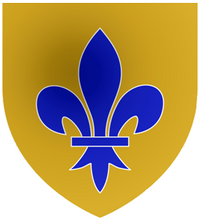Sir William Portman, 6th Baronet

Sir William Portman, 6th Baronet (5 September 1643 – 18 March 1690) FRS was an English politician who sat in the House of Commons between 1661 and 1690.
Portman was the son of
In 1661, Portman was elected
Portman married three times but died without issue and the baronetcy became extinct.[1]
Life
He was the eldest son of Sir William Portman, 5th Baronet (1610–1648) of Orchard Portman, by Anna, daughter and coheiress of John Colles of Barton. The father was returned for Taunton to both the Short and Long parliaments of 1640, but was disabled, as a royalist, to sit on 5 February 1644. On his death in 1648, William succeeded him as sixth baronet.[4]
He matriculated at
He was a strong ‘abhorrer’ during the exclusion crisis in Charles II's reign, and while attending parliament in May 1685 he received a mysterious warning of the
In November 1688 Portman joined the
Family and heirs
He married three times, but had no issue. He married firstly in 1661, Elizabeth, daughter and coheiress of Sir John Cutler, 1st Baronet by his first wife; secondly in 1674, Elizabeth, the daughter and coheiress of Thomas Southcote of Buckland Tout Saints, Devon and thirdly in 1682, Mary, the daughter and heiress of Sir John Holman, 1st Baronet of Banbury, Oxfordshire.[5]
He left his valuable estate to his first cousin Henry Seymour (d. 1728), the 5th son of his aunt Anne Portman (d.1695) and her husband
Sources
- History of Parliament, House of Commons, Members 1660-1690, published by History of Parliament Trust
 This article incorporates text from a publication now in the public domain: Lee, Sidney, ed. (1896). "Portman, William (1641?-1690)". Dictionary of National Biography. Vol. 46. London: Smith, Elder & Co.
This article incorporates text from a publication now in the public domain: Lee, Sidney, ed. (1896). "Portman, William (1641?-1690)". Dictionary of National Biography. Vol. 46. London: Smith, Elder & Co.
References
- ^ a b William Courthope, Debrett's complete peerage of the United Kingdom of Great Britain and Ireland
- ^ Leigh Rayment's Historical List of MPs – Constituencies beginning with "T" (part 1)
- ^ Leigh Rayment's Historical List of MPs – Constituencies beginning with "S" (part 3)
- ^ a b c d e . Dictionary of National Biography. London: Smith, Elder & Co. 1885–1900.
- ^ "PORTMAN, Sir William, 6th Bt. (1645-90), of Orchard Portman, Som. and Bryanston, Dorset". History of Parliament Trust. Retrieved 27 April 2019.
- ^ Deed Poll Office: Private Act of Parliament 1735 (9 Geo. 2). c. 22
- ^ Debrett's Peerage, 1968
